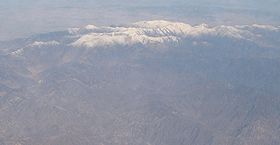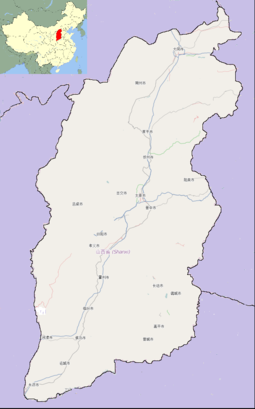Wutai Shan
| Mount Wutai | |
|---|---|
| 五台山 | |

Mount Wutai from the air
|
|
| Highest point | |
| Elevation | 3,061 m (10,043 ft) |
| Coordinates | 39°04′45″N 113°33′53″E / 39.07917°N 113.56472°ECoordinates: 39°04′45″N 113°33′53″E / 39.07917°N 113.56472°E |
| Geography | |
|
Wutai County, Shanxi, China
|
|
| Climbing | |
| Easiest route | Hike |
| UNESCO World Heritage Site | |
| Criteria | (ii), (iii), (iv), (vi) |
| Reference | 1279 |
| Inscription | 2009 (33rd Session) |
|
[]
|
|
| Mount Wutai | |||||||||||||||||||||||||||
|
"Mount Wutai" in Chinese characters
|
|||||||||||||||||||||||||||
| Chinese | 五台山 | ||||||||||||||||||||||||||
|---|---|---|---|---|---|---|---|---|---|---|---|---|---|---|---|---|---|---|---|---|---|---|---|---|---|---|---|
| Literal meaning | "Five Platforms Mountain" | ||||||||||||||||||||||||||
|
|||||||||||||||||||||||||||
| Transcriptions | |
|---|---|
| Standard Mandarin | |
| Hanyu Pinyin | Wǔtái shān |
| Wade–Giles | Wu3-t'ai2 shan1 |
| IPA | [ù.tʰâi ʂán] |
| Wu | |
| Romanization | Ng上 de入 se平 |
| Yue: Cantonese | |
| Yale Romanization | Ngh-tòih sāan |
| Jyutping | Ng5-toi4 saan1 |
| Southern Min | |
| Hokkien POJ | Ńgo͘-tâi-soaⁿ |
| Tâi-lô | Ngóo-tâi san |
Mount Wutai (Chinese: 五台山; pinyin: Wǔtái shān; literally: "Five Plateau Mountain"), also known as Wutai Mountain or Qingliang Shan, is a Buddhist sacred site at the headwaters of river Qingshui, in the Chinese northeastern province of Shanxi, surrounded by a cluster of flat-topped peaks (North, South, East, West, and Central). The North peak, called Beitai Ding or Yedou Feng, is the highest (3,061 m) and is also the highest point in northern China.
As host to over 53 sacred monasteries, Mount Wutai is home to many of China's most important monasteries and temples. It was inscribed as a UNESCO World Heritage Site in 2009.
Mount Wǔtái is one of the Four Sacred Mountains in Chinese Buddhism. Each of the mountains is viewed as the bodhimaṇḍa (dàocháng; 道場) of one of the four great bodhisattvas. Wǔtái is the home of the Bodhisattva of wisdom, Mañjuśrī or Wénshū (文殊) in Chinese. Mañjuśrī has been associated with Mount Wutai since ancient times. Paul Williams writes:
Apparently the association of Mañjuśrī with Wutai (Wu-t'ai) Shan in north China was known in classical times in India itself, identified by Chinese scholars with the mountain in the 'north-east' (when seen from India or Central Asia) referred to as the abode of Mañjuśrī in the Avataṃsaka Sūtra. There are said to have been pilgrimages from India and other Asian countries to Wutai Shan by the seventh century.
Wutai was the first of the mountains to be identified and is often referred to as "first among the four great mountains". It was identified on the basis of a passage in the Avataṃsaka Sūtra, which describes the abodes of many bodhisattvas. In this chapter, Mañjuśrī is said to reside on a "clear cold mountain" in the northeast. This served as charter for the mountain's identity and its alternate name "Clear Cool Mountain" (Ch: Qīngliáng Shān; 清涼山).
...
Wikipedia

